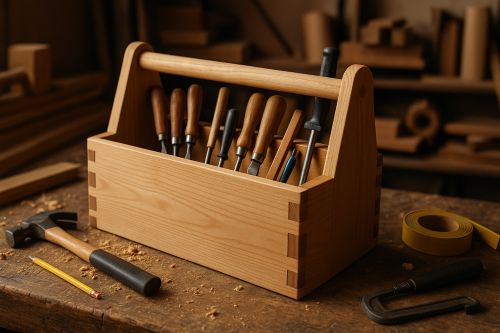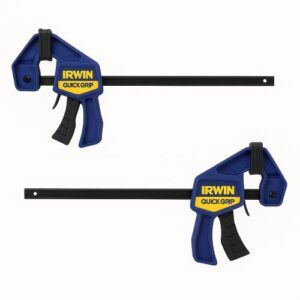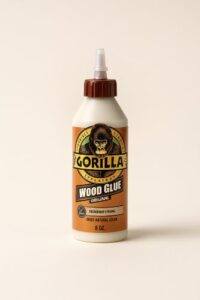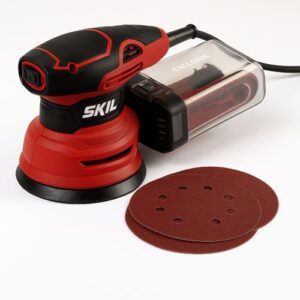Looking for a woodworking project that’s quick, practical, and actually gets used in your shop?
Building your own wooden toolbox checks every box.
It’s simple enough for beginners, rugged enough for everyday work, and a perfect way to sharpen your cutting, assembly, and finishing skills — all in one project.
In this guide, I’ll show you exactly how to build a classic open-top toolbox with a solid center handle and clean joinery. No complicated tools, no specialty hardware—just straightforward woodworking you can knock out in an afternoon. With a few boards and some basic shop tools, you’ll end up with a toolbox that’s strong, functional, and built to last.
⭐ Tool Essentials for Building a Wooden Toolbox
Before you jump into the cuts and assembly, it helps to have a few basic shop tools ready to go. A wooden toolbox might be a simple project, but it still needs solid glue-ups, clean sanding, and tight joints to look and feel right.
Here are three tools that make the whole build smoother, faster, and a lot more enjoyable:
🌟 Amazon Product Suggestion:
✔️ IRWIN QUICK-GRIP 6” One-Handed Mini Bar Clamp Set
(4-Pack)
These IRWIN Quick-Grip clamps are my go-to shop workhorses. Light, fast, and truly one-handed, they’re perfect for small builds like display cases, shelves, frames, and trim. Even with their compact size, they deliver solid pressure, lock cleanly, release smooth, and won’t dent your walnut thanks to the non-marring pads. If you want clamps you’ll actually enjoy using — these are the ones.
Why it’s great:
✓ One-handed operation makes positioning and clamping effortless
✓ Strong, consistent grip for small cabinet and display case builds
✓ Soft, non-marring pads protect delicate woods like walnut and cherry
✓ Lightweight design lets you run several clamps at once without fatigue
✓ Perfect for tight spots where full-size bar clamps won’t fit
✓ Extremely reliable — no slipping, no bending, no cheap-plastic flex
✓ Great for beginners and pros who want fast, frustration-free clamping
🌟 Amazon Product Suggestion:
✔️ Gorilla Wood Glue – 8 oz Bottle
(Natural Wood Color)
When you’re building a walnut display case — or anything that needs to stay together longer than you will — Gorilla Wood Glue is the stuff you reach for without thinking twice.
It’s strong, it’s predictable, it dries the right color, and it just works. Perfect for joints, edge-gluing panels, shelves, frames, and any woodworking project where reliability isn’t optional.
Why it’s great:
✓ Super strong bond — clamps up tight and holds like a tank
✓ Dries natural wood color — blends beautifully with walnut, oak, cherry, and maple
✓ Fast set time — ideal for small builds, cabinetry, trim, and furniture work
✓ Water-resistant formula — great for long-lasting, indoor woodworking projects
✓ Easy squeeze bottle — clean, controlled application with zero mess
🌟 Amazon Product Suggestion:
✔️ SKIL 5” Random Orbital Sander
(with Cyclonic Dust Box)
This SKIL 5” random-orbital sander is a killer little powerhouse — perfect for smoothing out your walnut display case, taking down glue squeeze-out, or prepping panels before finishing.
It’s compact, strong, and stupid-easy to control.
The built-in cyclonic dust box actually works (rare for budget sanders),
keeping the air cleaner while you work.
Why it’s great:
✓ Random-orbit finish for smooth, swirl-free sanding
✓ Cyclonic dust box that actually traps dust
✓ Comfortable grip for long sanding sessions
✓ Variable speed for precise control on any wood
✓ Low vibration for accuracy and less fatigue
Step 1: Cut the Side Panels to Size
Your toolbox starts with two matching side panels. These pieces set the overall height and give the handle something solid to attach to, so take your time and make clean, square cuts.
Action:
Cut two identical side panels from ¾-inch lumber. Make sure both pieces match exactly in height and angle, so the handle sits level later.
👉👉 Pro Tip: If the two sides don’t match, your toolbox is gonna look like it partied too hard last night. Stack them together and sand the edges flush to keep things clean.
Step 2: Cut the Front and Back Panels
With the sides finished, it’s time to cut the front and back of your toolbox. These pieces set the overall width, so measure carefully and keep everything consistent.
Action:
Cut one front panel and one back panel to your desired toolbox length.
Make them the same width and keep their height slightly shorter than the side panels so the handle clears comfortably.
👉👉 Pro Tip: When cutting twin pieces like this, rough-cut both, then clamp them together and trim the edges as one. It guarantees they match perfectly — and matching parts make everything downstream easier.
Step 3: Cut the Bottom Panel
The bottom panel ties the whole toolbox together. It needs to fit snugly between the front and back panels, so measure based on the pieces you’ve already cut—not the numbers on your sketch.
Action:
Measure the distance between the front and back panels, then cut one bottom panel to that exact width. Keep the length the same as your front and back pieces.
👉 This is one of those places where a tight fit makes your toolbox feel solid.
👉👉 Pro Tip: Always measure off the actual pieces, not the plan. Wood thickness can vary, and even a 1/16″ gap will make your toolbox feel sloppy.
Step 4: Cut the Handle and Handle Supports
The classic toolbox design uses a round dowel or hardwood rod for the handle.
It sits inside two upright supports attached to the side panels.
Get the length right, and your handle will sit centered and comfortable in your hand.
Action:
Cut one dowel (or hardwood handle) slightly wider than the toolbox.
Then cut two matching upright supports that will hold the handle in place.
Make sure the dowel fits snugly into the holes you drill.
👉👉 Pro Tip: Drill the holes for the handle supports before attaching them.
It’s way easier to keep everything straight when the pieces are still loose on your workbench.
Step 5: Assemble the Toolbox Frame
Now it’s time to bring the pieces together. The front, back, and bottom panels form a simple open box — nothing fancy, but getting these joints tight makes your toolbox feel rock-solid.
Action:
Dry-fit all four panels first to check alignment.
Then add wood glue along the edges of the bottom panel and clamp the front and back panels in place.
Finish by attaching the two side panels to complete the frame.
👉👉 Pro Tip: Don’t rush the glue-up. A few minutes spent adjusting clamps now prevents a crooked toolbox that annoys you for the next 20 years.
Step 6: Attach the Handle Supports
With the frame assembled, it’s time to mount the two upright supports that will hold your handle. These should sit centered on the side panels, with the holes you drilled earlier aligning perfectly with the dowel.
Action:
Position each support on the inside of the side panels, making sure they sit flush.
Add wood glue, clamp them in place, and secure them with finish nails or screws for extra strength.
👉👉 Pro Tip: Before the glue dries, drop the dowel into the holes to double-check alignment.
If it slides in smoothly now, the final assembly will be a breeze.
Step 7: Install the Handle
This is the satisfying part — sliding the dowel into place brings the toolbox to life. The handle should rotate freely but sit snugly enough that it doesn’t rattle around.
Action:
Slide the dowel through both support holes.
If the fit is too tight, lightly sand the ends of the dowel until it moves smoothly.
Once you’re happy with the feel, add a dab of glue on the inside of each support to lock it in place.
👉👉 Pro Tip: Don’t glue the entire handle — just the ends. A little bit of movement makes the toolbox more comfortable to carry and prevents the handle from splitting over time.
Step 8: Secure the Bottom Panel
Now it’s time to lock the bottom panel into the frame. This is where the strength of the toolbox really comes from, so make sure it’s supported well and fully seated before you fasten it.
Action:
Flip the toolbox upside down.
Pre-drill along the edges of the bottom panel, then secure it with wood screws or finish nails.
Wipe away any glue squeeze-out before it dries.
👉👉 Pro Tip: Pre-drilling prevents the bottom panel from splitting — especially if you’re using hardwood. It also keeps your fasteners from drifting and pulling the panel out of alignment.
Step 9: Add Dividers (Optional)
If you want a more organized toolbox, adding a few internal dividers can keep nails, screws, and small tools from sliding around. This step is optional, but it definitely boosts the toolbox’s usefulness.
Action:
Measure the inside width and cut thin strips of wood to create your dividers.
Glue or nail them into place wherever you want compartments.
Keep the spacing practical — leave room for your larger tools.
👉👉 Pro Tip: Don’t overcomplicate the layout. Simple, roomy compartments are more useful than a bunch of tiny sections you’ll never use.
Step 10: Sand and Finish the Toolbox
This is where your hard work pays off. A good sanding job and a clean finish make your toolbox look sharp and feel great in your hands. Plus, it protects the wood from shop grime and daily use.
Action:
Sand all surfaces with 120–220 grit until everything feels smooth.
Break the sharp edges with light sanding to make the toolbox more comfortable to carry.
Apply your finish of choice — oil, polyurethane, stain, or a simple wax — and let it dry fully before loading it with tools.
👉👉 Pro Tip: If you want a classic “shop-made” look, wipe on a coat of boiled linseed oil. It’s fast, forgiving, and brings out the natural beauty of the wood without overcomplicating things.
You’re Done — Enjoy Your New Toolbox!
Building a wooden toolbox isn’t just a quick weekend project — it’s a piece of shop gear you’ll use for years. You just turned a few boards into something sturdy, functional, and uniquely yours. And the best part? Every time you grab that handle, you’ll know you built it.
If you’re ready to keep the momentum going, here are a few projects that pair perfectly with this one:
-
✔ DIY Display Case – a clean, sharp project to level up your joinery
-
✔ 10 Woodworking Projects for Beginners – simple builds that keep your skills growing
-
✔ Woodworking Plans Homepage – find your next project idea fast
Keep building, keep learning, and keep enjoying the process.
Your next project is just a few cuts away.
Craft it. Shape it. Own it!
🧰 Need More Woodworking Plans?
👉👉 Click here to learn more about Ted’s Woodworking Plans:
If you want hundreds of additional project ideas with clear step-by-step instructions, my full review breaks down exactly what you get inside Ted’s Woodworking Plans.
It’s a great resource if you like weekend builds, simple jigs, or classic shop projects.
Check out the full review here → Ted’s Woodworking Plans
💡 Turn Your Woodworking Passion Into Income
👉👉 Click here to learn more about Wealthy Affiliate
SawdustSmarty started as a simple hobby.
It grew because I finally learned how to build a real website — the right way. If you’ve ever thought about turning woodworking into a side business or income stream, Wealthy Affiliate is the training I personally recommend.
Click here to read more → Wealthy Affiliate







